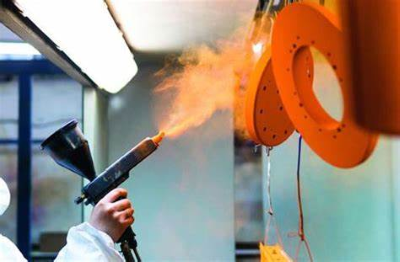Powder coatings began to be used for protection and electrical insulation. With the development of science and technology, it has been widely used in the automotive industry, electrical insulation, corrosion-resistant chemical pumps, valves, cylinders, pipes, outdoor steel components, steel furniture, castings, etc. surface coating.
Fluidized bed
Compressed air is introduced into the part of the container below the partition, and the compressed air passes through the porous partition to suspend the powder above without being affected by the air flow, and rolls in the upper container, showing a "boiling" state. The preheated workpiece passes through the "boiling" powder zone to achieve the coating effect. The preheating temperature of the workpiece can be slightly higher than the melting temperature of the powder.
Flame spray
In the oxyacetylene flame, the powder passes through the high-temperature area of the spray gun port at a speed of about 50m/s, is heated to a molten or semi-molten state, and is sprayed onto the preheated surface until it reaches the required thickness. The powder flame spraying process is relatively simple and can be used for spraying guide rail surfaces and repairing mechanical wear.
Hot melt painting
It is a process between flame spraying and fluidized bed. The process is to preheat the workpiece to above the powder melting temperature, then spray the powder on it with a spray gun, and use the heat of the workpiece to melt it into a coating.
Electrostatic powder coating
A high-voltage corona discharge electric field is formed between the spray gun and the workpiece. When the powder particles are ejected from the spray gun mouth and pass through the discharge area, a large number of electrons are collected and become negatively charged particles. Under the action of electrostatic attraction, they are attractted to positively charged workpieces. When the powder adheres to a certain thickness, a "homogeneity repulses" effect will occur, and the powder can no longer be adsorbed, thereby making the thickness of the powder layer in each part uniform. Then, after heating and baking, the powder layer will level out and become a uniform film layer.
Powder electrophoresis coating
It is the product of comprehensive powder coating and current coating, and has the characteristics of both. The basic principle is to disperse powder particles (generally required to be 40 μm or less) in an aqueous solution containing electrophoretic resin, using the aqueous electrophoretic resin as a carrier and the powder particles as film-forming substances, so that the powder particles are charged and exposed in a DC electric field. Film formation by electrophoretic deposition. It is suitable for the construction of workpieces with complex shapes.![]()

Advantages
A thicker coating can be obtained in one coating, for example, a coating of 100 to 300 μm. With ordinary solvent coatings, it takes about 4 to 6 coatings, while with powder coatings, this thickness can be achieved in one time. The corrosion resistance of the coating is very good.
Powder coating does not contain solvents, has no three wastes, and improves labor hygiene conditions.
It adopts new processes such as powder electrostatic spraying, which is highly efficient and suitable for automatic assembly line coating; the powder utilization rate is high and it can be recycled.
In addition to thermosetting epoxy, polyester, and acrylic, there are also a large number of thermoplastic greases that can be used as powder coatings, such as polyethylene, polypropylene, polystyrene, fluorinated polyether, nylon, polycarbonate, and various fluorine-containing coatings. Resin etc

